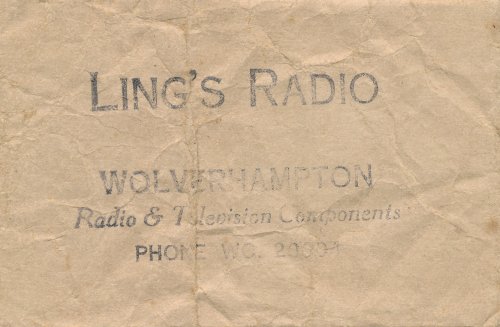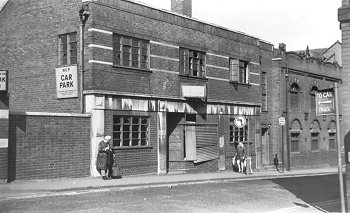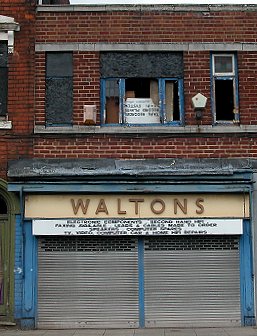|
Introduction by Bev
Parker
Engineering
today is perceived as unfashionable, but not so long ago
things were very different. Engineering was popular and
we had large numbers of engineers and many enthusiasts,
whose main hobby was engineering in one form or another.
People used to build pieces of electronic equipment at
home that varied from television sets, radios and hi-fi,
to amateur radio transmitters and receivers, computers
and things to do with the car. Accordingly there were
many magazines to buy and each town had at least one
shop that specialised in electronic components and test
gear. All kinds of components were readily available and
the variety of items that could be built was almost
endless.
Unfortunately
most of these shops have gone, because today there is
little demand for such parts and it is now difficult to
buy many items that were readily available in the 1960s,
70s and 80s. Wolverhampton had its fair share of such
shops, the main ones being Walton’s, Ling’s Radio, and
Fenwicks.

Walton’s
Wireless Stores at 203 Staveley Road first appears in
the Wolverhampton Red Books in the mid 1930s and appears
to be the company’s original premises. The shop was
still there in 1951 but by 1958 had moved to 48 Stafford
Street and by 1961 had moved again to 15 Church Street.
I well remember
the Church Street premises, a large Victorian shop that
contained an Aladdin’s cave, suitable for any
enthusiast. There were many pieces of electronic
equipment on display, some new, but mainly old; and of
course government surplus and ex-W.D. equipment were
commonplace in those days. There was also a fair share
of “junk” equipment, either not working or incomplete,
that could form the basis of a new project. Valves,
transistors and general components could be purchased at
good prices, as could such things as reel to reel tape
and tools. The staff were always friendly and helpful,
and Jack Dennes could be relied upon to make any visit a
happy and enjoyable occasion. |
|

An advert from "Practical
Wireless" August 1967. |
| In about 1965 the shop moved to
its final location at 55 Worcester Street. By this time
integrated circuits were starting to appear and Walton’s
became one of the main stockists in the area. They were
always willing to order any item that wasn’t in stock
and continued to offer a first class service. They could
get almost anything. I built my first television set in
about 1967 and wanted a plastic front from a
commercially available receiver. I had a brief word with
Jack about it and one week later it had arrived and was
awaiting collection. I got
to know the people at the shop extremely well, and
sometimes helped out by repairing odd pieces of test
equipment, which would later go on sale. Waltons were
well known in the area and customers often travelled
from all across the Black Country and parts of
Shropshire. I’m sure many people will still remember
their telephone number: Wolverhampton 22039.
Another popular electronics shop
was Ling’s Radio. The earliest reference I can find is
in the 1958 Wolverhampton Red Book when Ling’s
Television could be found at 153 Bilston Street. By the
early 1960s Ling’s Radio occupied a small shop next to
the synagogue in Fryer Street, and when this was
demolished in around 1965 to make way for the existing
car park, the business moved to Snow Hill, where it
remained until closure in the mid 1980s. The shop was
much smaller than Waltons and Geoff Ling was always
ready for a chat, especially if the subject was fishing,
his main hobby. It could be difficult to get away,
especially if you were in a hurry.
Neville
J. Haycox's memories of Waltons
Neville J.
Haycox has many memories of Waltons in the late 1940s.
After leaving Codsall Secondary Modern school on 22nd
July, 1946 at the aged of fourteen, he went to work for
Jack Dennes senior who was setting up his business as an
electrical company in Codsall village, after leaving the
Boulton Paul Aircraft Company, where he worked as an
electrical draughtsman during the war.
Neville's family were great friends
of Mr. and Mrs. Dennes and their son
Jackie, which is possibly why he was offered a job. He
was told that Mr. Dennes had at one time been bankrupt
and could not use his own name and therefore used the
name "Waltons Wireless Store" which was a business he
may have taken over.
While he worked
at Waltons they completed a number of house and business
rewiring jobs in the Codsall area, working from a wooden
shed in Jack's front garden. At the time there was a
shortage of 15 amp socket boxes, so Jack designed his
own and they manufactured enough to complete work where
others had failed. |

On the left is Neville
Haycox, with Jackie Dennes on the
right. Courtesy of Neville Haycox.
|
Mr. Dennes
branched off into bidding for ex-government surplus
stock which was off-loaded into what was then just a
town house in Staveley Road, with a counter set up in
the front room.
Neville stayed with the company for
about six months, dismantling government surplus
electrical and wireless equipment for components.
During that time he only remembers two or three
customers coming in to buy a few resisters, so he
decided to move-on and became an apprentice with a local
aircraft firm. |
Building radios in the
1960’s. Written by Frank Batkin
During the early 1960’s I developed an interest in
radio. However with me still being at school and money
being tight, I was forced to shop around for the bits
and pieces needed to build a wireless set. I was
really quite lucky here in Wolverhampton as there were
several places that I could obtain the various bits and
pieces needed. Wire, crystals, coils etc. could be
brought from Geo Davies’s shop in Bradmore, which
involved a good walk from home on a Saturday morning. It
is perhaps a sign of the times that the shop is still in
business but now also sells computer peripherals
too. Transistors could be obtained from Walton’s
wireless, which was then situated in Church Street,
Wolverhampton, now the location of Telecom house. In
those days transistors were expensive at 7 shillings and
sixpence each (around 45p in today’s money). The
transistors came in 3 types, red, green and blue
depending on their usage. Much ex-army surplus
stuff such as headphones could be obtained from various
junk shops along the Dudley road. Also on Snow hill was
Ling’s radio although you had to know exactly what you
wanted or Mr. Ling would not sell it to you. He was a
very clever engineer who smoked like a chimney and sadly
I believe this caused his early death. Valves could be tested at Fenwicks in Pitt Street,
although you had to be well heeled to buy much in the
way of radio bits here. |
| One of the small envelopes
used by Geoff Ling for components. |
 |

The empty shop in Fryer Street
where Ling's Radio used to be. Courtesy of David Clare. |
And so it was that a Saturday would be spent in a
circuit of shops starting in Church Street and ending on
the Dudley Road.
Waltons wireless was always a good place to get bits, it
was run by Jacky Dennes whose family owned the shop.
At some point in the early
60’s they moved to a site on Worcester Street. |
|
Jack retired in the 1970’s or 80’s and retired to East
Anglia. He was quite a character with a typical Black
Country wit. On one occasion I wanted several
yards of wire and he told me that they had gone
metric. He watched me wracking my brains to work out the
amount in Metres and when I asked how much it was he
told me it was 3d a foot.
He had an answer phone that informed you in a very broad
accent that as he wasn’t in, he was out. If I recall,
the message went on to say he had gone “wum fer his
Tay”. The shop carried on after he left but closed down
after a while. The shop is now due for demolition as
part of the new urban village project for the
city. Today no one would entertain the idea of building
their own wireless. The price of chips and transistors
has made it uneconomical to so do. But there was nothing
like the feeling that came from hearing voices and music
from out of the ether on a home made radio. |

Waltons shop in Worcester Street
prior to demolition. |
 |
Return to the
previous page |
|